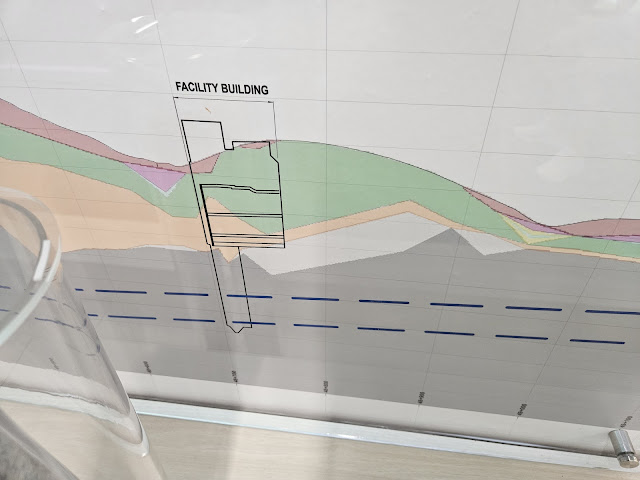 |
| 27 July 2024 - A view of the front of the training centre with the project site behind the white noise barriers. |
The Land Transport Authority (LTA) launched visits to the Cross Island Line (CRL)'s contract CR202 Biodiversity Training Centre (BTC) on 16th July 2024. The team subsequently made a visit to the BTC where one could learn a bit more about the contract and the special training that workers undergo before being deployed to the project. The contract for the construction of the large diameter single bore tunnel involves tunneling through the Central Catchment Nature Reserve (CCNR), an environmentally sensitive section of the country where wildlife thrives. In view of this, additional training is required to allow workers at the site to pick up knowledge on practices to minimise impact on the environment, animals and plants near the work site.
If you're interested to visit the BTC, you can sign up here: https://go.gov.sg/crl-btc
 |
| 27 July 2024 - An Instagram-worthy feature wall within the BTC. |
 |
| 27 July 2024 - The wall to the right of the corridor is filled with posters detailing the animals that can be found around the CR202 launch shaft work site, at the location of the former Rider's Cafe. |
The BTC serves as an education centre, where visitors can learn about the types of animals commonly found around the CR202 launch shaft work site, which is located where Rider's Cafe used to be. A wall along one of the corridors is tastefully decorated with posters featuring write ups about the animals found here - such as Wild boars, Raffles' banded Langurs, Pangolins and Pythons. Some animals may require special skills to handle, for instance should workers come across one of the Cobras found locally - the Black spitting cobra or King cobra. It is here, that workers are trained in the do's and don'ts when it comes to encounters with the critters.
 |
| 27 July 2024 - Exhibit panels on the efforts being undertaken at the site to co-exist with nature while keeping the workers at the site safe & in good health. |
Beyond educating the workers and visitors to the centre on best practices for keeping a worksite clean and pest-free, the centre also displays other exhibits. Special measures were taken at the site to prevent animals from becoming trapped in ground mats for instance. One section of the BTC is dedicated to explaining the measures employed, such as using special, looser materials in the earth mats that allowed snakes to wriggle free should they become entangled or minimising reflective surfaces of windows to prevent birds from flying into window panes.
 |
| 27 July 2024 - The exhibit showcasing the measures adopted to in equipment and practices to be environmentally-friendly. |
 |
| 27 July 2024 |
 |
| 27 July 2024 |
In a bid to be more aware about the impact of human activities on the environment, the BTC also promotes recycling, upcycling and reuse of waste materials. Several examples can be seen on display - from stools created from empty plastic milk cartons to furniture crafted from disused metal oil drums. When the team visited the BTC, we were especially inspired by all the possibilities that could be made possible.
 |
| 27 July 2024 - A view of the seat made from a former metal oil drum. |
 |
| 27 July 2024 - Timbre that was produced from the construction site was reused in a variety of ways, from making furniture to other household products. |
 |
| 27 July 2024 |
 |
| 27 July 2024 - Items made from recycled plastics. The stool was made from plastic milk cartons while the coaster was made from recycled construction hard hats. |
In addition to learning about the environmental measures to be employed through the duration of the project, some information is also available about contract CR202. Displays of the tunnel alignment, specifically chosen to run deep underneath the ground level at approximately 70 metres below, adorn one of the walls at the the BTC. The tunnel was also specifically routed to keep beneath the existing paths through the CCNR so that the project team could ensure that works were done in areas that were more open for the deployment of measuring & monitoring devices to avoid disturbance to the surface and natural vegetation.
 |
| 27 July 2024 - A large display map of the tunnel alignment from Fairways Drive to Sin Ming Walk. |
 |
| 27 July 2024 - A model of the tunnel boring machine to be used for the project. |
 |
| 27 July 2024 - Details of the buildings to be constructed along the route but outside of the CCNR. No structures will be built within the reserve. |
One's initial reaction to a project taking place in an ecologically-sensitive area could be to immediately reject the idea. However, when due consideration and respect is given to the site, it could also yield opportunities to discover much more about the CCNR and its inhabitants. We do recommend that you make a visit to the BTC to learn more about the efforts undertaken to make the project one that respects the environment - be it in interactions with plants or animals or in thinking of new ways to minimise the impact of our waste on our surroundings.
This post will also be available on Instagram & Facebook on 9 August 2024.


No comments:
Post a Comment